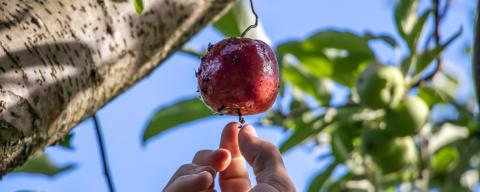SHARE

Use this worksheet when preparing chemicals with application rates presented in amount of product per volume of spray solution, such as fl. oz. per gallon or lbs per 100 gallons.
Retain the following information for your records:
Date _____________________
Business ____________________________________________
Operator ____________________________________________
Sprayer Identification
Sprayer Identification
Sprayer ___________________
Pressure __________________
Tip _______________________
Pressure __________________
Tip _______________________
Location Information
Greenhouse____________________________________________
Growth stage___________________________________________
Growth stage___________________________________________
Hangers Present? _______________________________________
How much do you spray with this sprayer in this house at this stage of growth?
To know how much chemical to mix, you need to know how much spray volume you will need for the area to be treated. By calibrating yourself to your sprayer to the crop at this stage of growth, you can start off with the correct amount of spray.
Step 1: Find the square footage of a portion of your greenhouse to test.
Step 1: Find the square footage of a portion of your greenhouse to test.
Perhaps this is a few benches or a given section of floor, but the crop in it should represent the crop throughout the section to be sprayed. Calculate the “test area” by multiplying the length of the test section times the width of the test section (not including aisles).
_______square feet (“test area”)
Step 2: Figure out how much liquid it takes to spray the test area.
_______square feet (“test area”)
Step 2: Figure out how much liquid it takes to spray the test area.
In your sprayer, put more water than you think will be needed to spray the “test area”. Do not add any pesticide for this step; you are simply determining how much you spray with that sprayer in a given area. The amount you start with is the “initial volume”. Spray the “test area”, giving the same coverage you would during a real spray. When you finish the “test area”, measure how much water is still in the tank. This is the “remaining volume”.
Calculate the volume used for this test (“test volume”)
“Initial volume” minus “Remaining volume” equals “Test volume”
_________gallons - ________gallons = _______gallons (“test volume”)
_________gallons - ________gallons = _______gallons (“test volume”)
Step 3: Measure the total square footage to be sprayed with chemical.
This may be the entire greenhouse or just a portion. Call this the “spray area”. The “spray area” is the length times the width (not including the aisles).
_______square feet (“spray area”)
Step 4: Calculate how much spray you need for the “spray area”.
_______square feet (“spray area”)
Step 4: Calculate how much spray you need for the “spray area”.
This is the total amount of liquid (water plus chemical) you will need in your tank. Call this the “spray volume”.
“Test volume” times “Spray area” divided by “Test area” equals “Spray volume”
“Test volume” times “Spray area” divided by “Test area” equals “Spray volume”
____gallons (“test volume”) X ____square feet (“spray area”) ÷___square feet (“test area”) = _____gallons (“spray volume”)
Step 5: Calculate how much chemical to use.
Step 5: Calculate how much chemical to use.
This will be the amount of chemical you mix into the “spray volume” to treat your crop. Call this the “spray chemical”. The label may give this to you in “ounces, fluid ounces, lbs, etc per gallon”. If so, simply multiply that number times the “spray volume” to find “spray chemical”.
More likely, the label will tell you how much chemical to use (in ounces, fluid ounces, lbs, etc.) per 100 gallons. If so, calculate “spray chemical” as follows:
“Chemical per 100 gallon” times “Spray volume” divided by 100 equals “Spray chemical”
____oz, floz, lbs (“chemical per 100 gallon”) X ____gallon (“spray volume”) ÷ 100 = _____oz, floz, lbs (“spray chemical”)
Step 6: Mix your tank.
“Chemical per 100 gallon” times “Spray volume” divided by 100 equals “Spray chemical”
____oz, floz, lbs (“chemical per 100 gallon”) X ____gallon (“spray volume”) ÷ 100 = _____oz, floz, lbs (“spray chemical”)
Step 6: Mix your tank.
Fill the tank to approximately ½ of the “spray volume” using clear water. Add “spray chemical”. Continue filling the tank to the “spray volume”. Always follow mixing directions on the label.
Jonathan Ebba, Extension Field Specialist & George Hamilton, Extension Field Specialist
Jonathan Ebba, Extension Field Specialist & George Hamilton, Extension Field Specialist
December 20, 2019
Extension Services & Tools That Help NH Farmers Grow
Newsletters: Choose from our many newsletters for production agriculture
Receive Pest Text Alerts - Text UNHIPM to (866) 645-7010
Contact
Landscape & Greenhouse Field Specialist
Email: Jonathan.Ebba@unh.edu
Office: Barton Hall & Cole Hall, Room C146, Durham, NH 03824
Topics
Types

